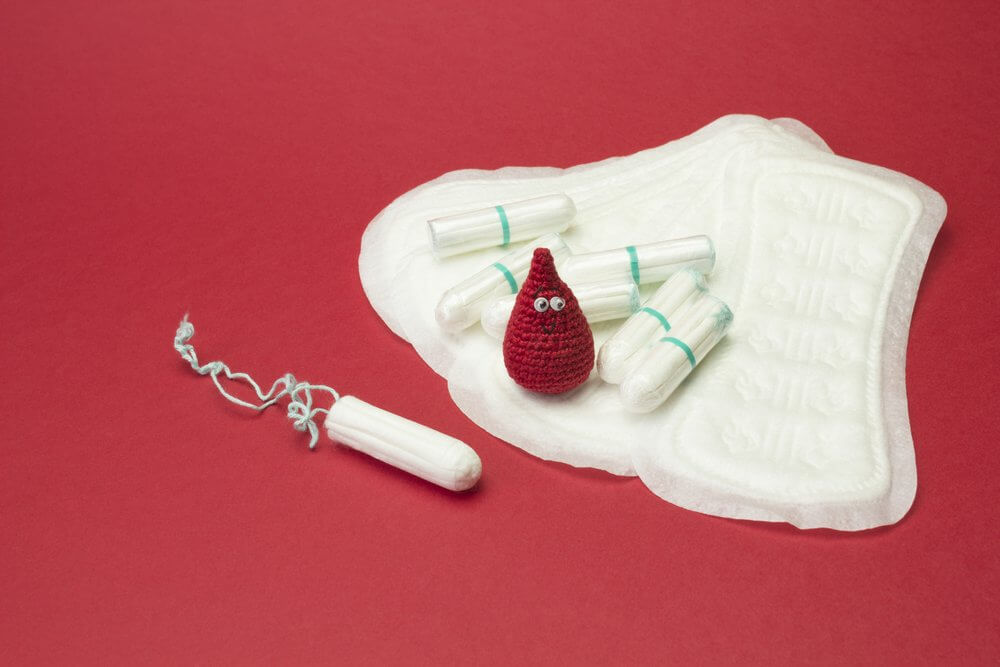What the Color of Menstrual Blood Reveals


Reviewed and approved by the nurse Leidy Mora Molina
The color of menstrual blood is an indicator of your state of health. This is because menstrual blood is made up of bodily waste such as lipids, proteins, hormones (including progesterone), stem cells, water, dead cells from the uterine lining, and organic toxins.
Basically, menstrual blood combines all the waste brought about by a woman’s lifestyle. These factors can range from her diet, or daily activities, to the products she uses.
But how well do you know your cycle? Have you ever analyzed the color? Having a period can become so mundane that you may not have every considered these details. However, it’s important to ask, what is the color of your menstruation?
There are 3 key aspects that you shouldn’t ignore: the amount of blood, the color, and the consistency. What’s normal? How do you know that there’s nothing to worry about? Do you really need to check these three things every month? In this article, we’ll tell you more.
Pay attention to your menstrual blood
Some periods are very light, and others are very heavy, which is completely normal. As long as it’s consistent. But if it changes suddenly, pay attention. If you’re not getting enough fluids your period will be light. However, if it’s very heavy (menorrhagia) it could be that you have a problem with one of your organs.
When your body expels menstrual fluid, it’s getting rid of energy stored in the body. If you’re doing exhausting activities, the fluid will be more liquid. On the other hand, if you have clots this could be due to stress.
Pay attention to the color
Generally, this depends on your liver. If it’s not well hydrated or experiences higher temperatures, the color will change.

Pinkish
Often, this type of bleeding lasts more than two days. If you experience this regularly, it could be a sign or weakness and low defenses. However, if suddenly the color of the blood is temporarily pinkish and then returns to normal, it’s possibly sign of an early pregnancy. Otherwise, it could be a sign or hormonal changes or an infection.
Intense red
An intense color of menstrual fluid means that it’s just been expelled. It has a light consistency and is common. There’s nothing to worry about.
Dark red menstrual blood
If your menstrual blood has a purple hue and a “dry” flow, this means that the waste is old. For some reason, it stayed in the uterus for longer and has taken a darker color. At the beginning of your period, you may expel blood from your previous cycle.
Read about Irregular Vaginal Bleeding & Why It Happens
Dark brown
This kind of vaginal discharge is completely normal at the end of your period. There will be little flow. It consists of the final residue. Generally, it’s uterine tissue that needs to be expelled for it to regenerate.
Orange menstrual blood
It’s sometimes possible for the blood in the cervix to mix with menstrual blood. This means you’ll see a mixed fluid with orange and red colors. If the orange color is stronger, you should go to a gynecologist, as it’s possible that you have an infection.
Learn The Five Worst Lies You Can Tell Your Doctor
Tips for a good cycle
Remember to stay hydrated on a daily basis. Health and nutrition experts recommend drinking enough water throughout the day, depending on your thirst. You don’t have to drink two quarts of water every day.
It’s worth resorting to hot teas, since in addition to hydrating you, they help blood circulation, increase the frequency of urination and reduce swelling.
Additionally, try to watch what you eat and avoid excesses. Keep in mind that sudden changes in the way you eat alter your emotions and physical state, including the color of your menstrual blood. We recommend eating foods rich in tryptophan, such as bananas, cereals, bread and rice, since they help the production of serotonin.

Also, stay away from fatty foods. This is because junk food and menstruation aren’t a good combination, as they’re a trigger for constipation and estrogen reduction.
Another aspect you should take care of is your rest. Therefore, in this regard, try to get enough sleep every day. It’s important to rest to strengthen defenses, improve digestion and have a good heart function.
Finally, don’t forget to do physical exercise. Going outdoors helps release tension. In addition, if you perform physical activity outside the home or gym, the body will release endorphins that’ll help relieve pain.
If in doubt, consult your gynecologist
The color of your menstrual blood is a detail that you shouldn’t overlook. Although its changes aren’t always a sign of something serious, sometimes they can help detect infections or low defenses. It’s also important to be aware of other characteristics such as abundance and consistency.
If there are abnormalities, it’s best to seek medical or gynecological attention to determine what’s causing them. This is because the professional, through a series of tests, can identify if the changes in menstrual bleeding have an underlying cause.
All cited sources were thoroughly reviewed by our team to ensure their quality, reliability, currency, and validity. The bibliography of this article was considered reliable and of academic or scientific accuracy.
- Critchley HOD, Babayev E, Bulun SE, Clark S, Garcia-Grau I, Gregersen PK, Kilcoyne A, Kim JJ, Lavender M, Marsh EE, Matteson KA, Maybin JA, Metz CN, Moreno I, Silk K, Sommer M, Simon C, Tariyal R, Taylor HS, Wagner GP, Griffith LG. Menstruation: science and society. Am J Obstet Gynecol. 2020 Nov;223(5):624-664.
- Dasharathy SS, Mumford SL, Pollack AZ, Perkins NJ, Mattison DR, Wactawski-Wende J, Schisterman EF. Menstrual bleeding patterns among regularly menstruating women. Am J Epidemiol. 2012 Mar 15;175(6):536-45.
-
Thiyagarajan DK, Basit H, Jeanmonod R. Physiology, Menstrual Cycle. In: StatPearls [Internet]. Treasure Island (FL): StatPearls Publishing; 2022 Jan.
- The morphology of normal menstrual blood and its diagnostic value. Geist, Samuel H. American Journal of Obstetrics & Gynecology. Vol 18, Issue 3, 321- 332.
- Various authors. Menstrual blood closely resembles the uterine inmune microenvironment and is clearly distinct from peripheral blood. Human Reproduction, 2014. Vol. 29, Nº 2: 303 – 314. [Online].
This text is provided for informational purposes only and does not replace consultation with a professional. If in doubt, consult your specialist.








